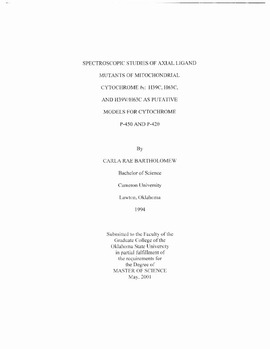| dc.contributor.author | Bartholomew, Carla Rae | |
| dc.date.accessioned | 2014-09-18T14:40:24Z | |
| dc.date.available | 2014-09-18T14:40:24Z | |
| dc.date.issued | 2001-05-01 | |
| dc.identifier.uri | https://hdl.handle.net/11244/10918 | |
| dc.description.abstract | In this work, spectroscopic characteristics describing each of the three OM cyt b5 mutants (H39C, H63C, and H39VIH63C) have been obtained. The results of these investigations point to oxidation of the cysteine to cysteinsulfinic acid and further oxidation to cysteic acid in the absence of oxidants other than air. This is a unique characteristic of these mutants. To date, the explanation given for the failure of thiolateFe ligation in the ferrous forms of the Mb mutants and the inactivity of ferric P-420 and C-420 has been protonation of the thiolate or elongation of the Fe-thiolate bond [6, 9, 10]. The work presented here provides an alternate explanation with evidence of oxidation of the cysteine. | |
| dc.format | application/pdf | |
| dc.language | en_US | |
| dc.publisher | Oklahoma State University | |
| dc.rights | Copyright is held by the author who has granted the Oklahoma State University Library the non-exclusive right to share this material in its institutional repository. Contact Digital Library Services at lib-dls@okstate.edu or 405-744-9161 for the permission policy on the use, reproduction or distribution of this material. | |
| dc.title | Spectroscopic Studies Of Axial Ligand Mutants Of Mitochondrial Cytochrome Bs: H39C, H63C, And H39Vih63C As Putative Models For Cytochrome P-450 And P-420 | |
| dc.type | text | |
| osu.filename | Thesis-2001-B287s.pdf | |
| osu.accesstype | Open Access | |
| dc.type.genre | Thesis | |
